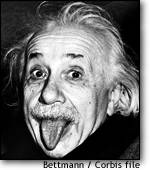



Connections Through Time, Issue 9: October - December 2000
![]()
 |
in a playful mood in 1951, focused on light's velocity in his theory of special relativity. |
In the July 20, 2000 issue of Nature magazine, a new experiment has more clearly than ever reproduced earlier experiments showing that a pulse of light can break the ultimate speed limit of c = 186,282 miles per second. The lead physicist on the experiment, Lijun Wang of the NEC Research Institute in Princeton, N.J., said "there are lots of questions to be answered" about the true nature of light. Raymond Chiao, a professor of physics at Berkeley who first predicted that light pulses could surpass the speed of light commented, "People have said nothing can go faster than light. Nothing is too strong a word."
Ultra-fast light pulses are possible because light, unlike matter, has no mass and can be viewed as a series of particles and as waves. "Einstein's theory of relativity still holds," Wang said. The new experiment does not mean that ordinary objects somehow can go backward or forward through time, said Chiao, "no, you can't kill your ancestors." That's good to know! :-)
The experimenters used a 2.4-inch glass cell filled with cesium vapor. They used two laser pulses to raise the energy of the cesium atoms to a specific altered energy state. A precisely tuned third laser soaked up the excess energy and a pulse shot out of the cell at a speed faster than light. According to Wang and several other physicists, the reason the light behaves the way it does is that when the leading edge of that third laser pulse begins to enter the chamber, it carries with it all the information needed to reconstruct the entire light wave. That allows the cesium atoms in the chamber to spit out a light beam before the entering pulse has fully reached them.
So, some of the atoms are informed, at speeds faster than the speed of light, that they should move out of the glass cell. Doesn't that sound like precognition?
This type of information is able to travel faster than the speed of light, and currently, most physicists would say that this is a special case where the pulse did not have enough content to be considered "real information". Nevertheless, the fact that this can occur at all and is accepted by science as part of our reality is an important step in the direction of joining physics and the reality of precognition.
For more details on the current scientific viewpoint concerning superluminal (faster than light speed) motion, tachyon particles, etc., see the third reference below.
References
"A Pulse of Light Breaks the Ultimate Speed Limit", Los Angeles Times Article by Usha Lee McFarling, Times Science Writer, July 20, 2000
Clarifying Einstein's rules of the road
Superluminal Motion: Fact or Fiction?
Go to another section of this issue:
Intuition:
Free Will and Precognition Applications:
Year 2000 plus/minus 50
![]()